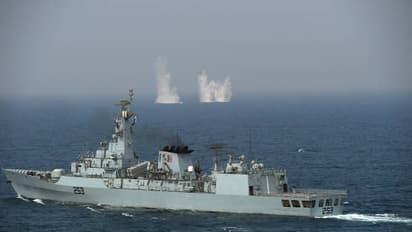Obsolete and immobilised: How Operation Sindoor EXPOSED Pakistan Navy's failures

Synopsis
India's Operation Sindoor has exposed the Pakistan Navy's critical fault lines, showing how obsolete platforms and chronic maintenance issues have bottlenecked its operational effectiveness.
New Delhi: India's decisive military response to Islamabad's state-sponsored terrorism, Operation Sindoor, has exposed the Pakistan Navy's critical fault lines, showing how obsolete platforms and chronic maintenance issues have bottlenecked its operational effectiveness.
As the dust settles, a clear narrative emerges: Pakistan's naval fleet, hamstrung by outdated submarines and unreliable frigates, failed to mobilise even basic fleet operations during the crisis.
Operation Sindoor has only confirmed what analysts have long said about the Pakistan Navy's fundamental platform weaknesses, which are rooted in obsolete submarines, unreliable frigates, and chronic underfunding, crippling its operational effectiveness.
According to the Global Firepower Index 2025, the Pakistan Navy operates a fleet of around 121 vessels, including submarines and frigates, but faces significant challenges due to outdated platforms and budgetary constraints.
While Pakistan has benefited from material acquisitions through its relationship with China, persistent economic and technological limitations have hindered its ability to modernise and maintain its fleet at par, let alone compete, with regional rivals.
These factors contribute to a notable gap in overall naval capability, especially when compared to India, which holds a clear advantage in maritime strength and operational readiness.
As India surges ahead with modern fleet capabilities, Pakistan's navy faces strategic vulnerabilities, which are likely to persist unless it can overcome deep-seated technological and financial challenges.
Evidence of obsolescence and operational failures
Satellite imagery from March 2025 provided indisputable evidence of the Pakistan Navy's dire state. Of the five Agosta-class submarines -- long considered the backbone of Pakistan's underwater deterrent -- only two were operational.
The other three submarines remained idle at Karachi Shipyard, stuck in lengthy maintenance cycles or left stranded on land. Essential overhauls of their MESMA AIP systems and structural upgrades were repeatedly delayed by supply chain issues and budget constraints. Notably, one Agosta-90B was even seen beached ashore -- a striking illustration of the fleet's lack of readiness.
The highly anticipated next-generation Hangor-class submarines, meant to revitalise Pakistan's underwater fleet, have also fallen prey to significant delays. The first two vessels, PNS Hangor and Shushuk remain under construction in China, with their deliveries now postponed to late 2025 and 2026.
The local assembly of subsequent boats at Karachi Shipyard is hindered by fiscal constraints, threatening to extend Pakistan's capability gap into the next decade.
Furthermore, even the country's surface fleet performance was no better. The Chinese-built Type-054A/P (Tughril-class) and F-22P (Zulfiquar-class) frigates—ostensibly the navy's most modern surface combatants—suffered from persistent technical failures.
Reports detail defective infrared sensors, unreliable search and track radars, and chronic engine problems that left several ships unable to sustain high-speed operations or maintain combat readiness. In several cases, main engine degradation and faulty cooling systems forced ships to operate at reduced capacity or remain docked for repairs.
Inability to mobilise during Operation Sindoor
These deficiencies translated into a tangible inability to mobilise during Operation Sindoor. When India launched its campaign, Pakistan's navy, from a naval strategy perspective, was unable to field a credible submarine deterrent or deploy its main surface fleet in a coordinated manner.
The operational Agosta-class submarines were limited in endurance and range, while the non-seaworthy boats sat idle. The Type-054A/P frigates, plagued by technical issues, failed to provide effective air defence or sea control.
Pakistan's inability to field a modern, reliable fleet during a crisis has profound strategic implications. Its reliance on diesel-electric submarines with limited underwater endurance and the questionable operational range of its Babur-3 SLCM undermines its second-strike credibility.
India's robust naval fleet has long demonstrated seamless integration of advanced platforms, ranging from indigenous aircraft carriers and destroyers to state-of-the-art submarines and maritime patrol aircraft.
Such coordination has long validated India's ability to conduct complex, multi-domain operations while underlining its dominance in the Indian Ocean Region.
Stay updated with the Breaking News Today and Latest News from across India and around the world. Get real-time updates, in-depth analysis, and comprehensive coverage of India News, World News, Indian Defence News, Kerala News, and Karnataka News. From politics to current affairs, follow every major story as it unfolds. IMD cities' weather forecastsRain Cyclone Asianet News Official App